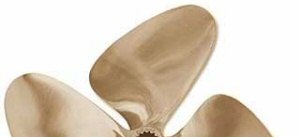
The prop, in conjunction with your engine, is the muscle of your boat. It is amazing the amount of difference there is when a prop is conditioned properly. The prop is tuned for a combination of your hull, your engine and the displacement of the boat. In addition to the proper pitch, there must be enough blade area to move the boat at the intended speed.
Props will need reconditioning for several reasons, but the most prevalent one is impact. Anytime you strike something with your prop, you should have it reconditioned. And if you have twin screws, it makes sense to have the other one done at the same time because props that are tuned together are more efficient working in tandem. Tuned props working in tandem will also lessen the chances of prop vibration (or cavitation).

When having props reconditioned, it is also a good idea to provide the propeller shop all the pertinent information about your boat. If not, they will simply tune the prop to it’s current configuration. If provided with information about your boat, hull and engines, they may be able to tweak the prop for better performance and fuel efficiency or make recommendations on alternative props.
Number of blades – While many boats are equipped with three-blade props for speed at the top end, four-blades may be a better choice for heavier boats, because four-blades may run more efficiently at cruising speeds. While you might lose a knot or two from your top end, you might gain a knot in the range that is commonly used. With fuel prices at an all time high, any fuel savings will reap big benefits.
Below are some common propeller terms:
Pitch – the theoretical distance in inches that a propeller moves forward in one revolution. Think of a screw in wood. If you increase the angle of the threads, it will move further into the wood in one turn.
Diameter – the diameter in inches of the circle that the blade tips will cut. Or, the distance in inches from a blade tip to the center of the prop, multiplied by two.
Propeller Size – props are named by the diameter inch number, followed by pitch inch number (i.e. 14 x 19 or 14″ diameter x 19″ pitch).
Blade – the part of the prop that provides the thrust.
Hub – the center part of the propeller. The hub, as an actual part, is the piece that fits inside the barrel of a prop and what the shaft slides into. If you strike something, the hub breaks free of the barrel and spins so that you don’t damage the drive-train.
Skew – a blade whose shape sweeps in a curve that follows its rotation is said to have a skew.
Rake – if a blade is perpendicular to the hub, that prop has no rake, or zero rake. If the blade leans back more towards the trailing edge of the prop, it is said to have rake. If it leans way back, it is a high rake prop. Rake is usually measured in degrees.
To operate at peak efficiency, a prop needs to be clean. We often find barnacle encrusted props and wonder how it ever moved a boat. If water can not glide off the prop, you will be losing motion on every rotation. We began using a coating called Propspeed several years ago and have found it to be very effective for keeping props clean and “slippery”. Although it is expensive it may be more cost effective than the wasted fuel of turning dirty props.
If you would like to play around a bit, I found a neat prop calculator spread sheet available for download –
Prop Calculator.
 The prop, in conjunction with your engine, is the muscle of your boat. It is amazing the amount of difference there is when a prop is conditioned properly. The prop is tuned for a combination of your hull, your engine and the displacement of the boat. In addition to the proper pitch, there must be enough blade area to move the boat at the intended speed.
Props will need reconditioning for several reasons, but the most prevalent one is impact. Anytime you strike something with your prop, you should have it reconditioned. And if you have twin screws, it makes sense to have the other one done at the same time because props that are tuned together are more efficient working in tandem. Tuned props working in tandem will also lessen the chances of prop vibration (or cavitation).
The prop, in conjunction with your engine, is the muscle of your boat. It is amazing the amount of difference there is when a prop is conditioned properly. The prop is tuned for a combination of your hull, your engine and the displacement of the boat. In addition to the proper pitch, there must be enough blade area to move the boat at the intended speed.
Props will need reconditioning for several reasons, but the most prevalent one is impact. Anytime you strike something with your prop, you should have it reconditioned. And if you have twin screws, it makes sense to have the other one done at the same time because props that are tuned together are more efficient working in tandem. Tuned props working in tandem will also lessen the chances of prop vibration (or cavitation).
 When having props reconditioned, it is also a good idea to provide the propeller shop all the pertinent information about your boat. If not, they will simply tune the prop to it’s current configuration. If provided with information about your boat, hull and engines, they may be able to tweak the prop for better performance and fuel efficiency or make recommendations on alternative props.
Number of blades – While many boats are equipped with three-blade props for speed at the top end, four-blades may be a better choice for heavier boats, because four-blades may run more efficiently at cruising speeds. While you might lose a knot or two from your top end, you might gain a knot in the range that is commonly used. With fuel prices at an all time high, any fuel savings will reap big benefits.
Below are some common propeller terms:
When having props reconditioned, it is also a good idea to provide the propeller shop all the pertinent information about your boat. If not, they will simply tune the prop to it’s current configuration. If provided with information about your boat, hull and engines, they may be able to tweak the prop for better performance and fuel efficiency or make recommendations on alternative props.
Number of blades – While many boats are equipped with three-blade props for speed at the top end, four-blades may be a better choice for heavier boats, because four-blades may run more efficiently at cruising speeds. While you might lose a knot or two from your top end, you might gain a knot in the range that is commonly used. With fuel prices at an all time high, any fuel savings will reap big benefits.
Below are some common propeller terms:

